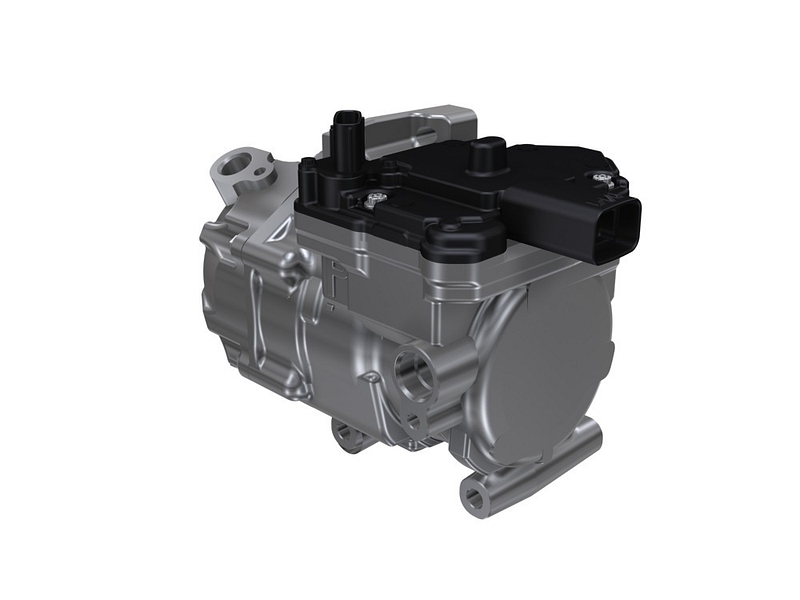How do the compressors differ in hybrid and electric vehicles?
Although there are naturally many similarities between the air conditioning (AC) systems in hybrid and electric vehicles and those powered by a traditional combustion engine, there are also several distinctions, not least in the compressor, which is the component at the heart of both.
When it comes to their function, while both are designed to provide the vehicle’s occupants with the most comfortable cabin environment, the AC system in a hybrid or electric vehicle also has the vital job of cooling the battery that powers the vehicle.
“If the AC system in a ‘normal’ car fails, you can still drive, but if it fails in an electric vehicle it won’t run, as the battery temperature is no longer controlled,” explains Richard Groot, AC product specialist at DENSO AM. “The AC system is therefore an integral element in the vehicle’s correct operating parameters and must be maintained accordingly, this includes the compressor, which in these vehicles is electrically driven and so defined as an eCompressor.”

What is an eCompressor and how does it work?
Conventional compressors are powered mechanically by the engine’s auxiliary drive belt, but as electric vehicles don’t have an engine that needs a belt-driven drive system, an eCompressor is required.
DENSO eCompressors include:
- Compressor section – scroll type compressor to draw in, compress and discharge refrigerant
- Electric motor – a direct current (DC) brushless type, using a permanent magnet as a rotor and coil for the stator, to drive the compressor
- Inverter – drives the motor and converts DC from the high voltage (HV) battery into alternating current (AC) for the motor. The AC electronic control unit (ECU) inputs compressor rotational speed signals to the inverter via the HV ECU, to control the rotational speed of the electric compressor
The electric motor runs at more than 200 volts and is cooled by refrigerant and oil mix, so a special, insulating compressor oil is required to prevent failure of the motor. Therefore, using the wrong oil brings a big risk of damaging the motor.
Fuel saving benefits and much more
The design of DENSO eCompressors brings several benefits to hybrid and electric vehicles:
- Controlled revolution eCompressors provide high performance at low revolution speed, which saves energy and the less energy that is used to drive the compressor, means more can be used to drive the vehicle and its usable range will increase.
- A DENSO eCompressor also consumes less energy, which helps to extend the range of the HV battery pack. Although many use a LION (lithium ion) battery, a NiMh (nickel metal hybrid) alternative is used in several Toyota hybrid models, for example.
- The internal electric motor enables the AC to continue to operate when the hybrid/electric system is switched off
- DENSO eCompressors are quieter, whilst retaining the same cooling capacity
Working with eCompressors
Safety first
Safety is paramount. The eCompressor is driven by the HV battery pack with an output of between 200 and 400 volts, so they can’t simply be replaced, they must first be disconnected from the vehicle’s HV battery.
Correct oil
eCompressor oil (usually) differs from the oil used in mechanical driven compressors. DENSO ND-Oil 11 is a highly insulating POE oil and in most cases is what is required, but always check the vehicle manufacturer’s specified formulation requirement, particularly as the wrong oil can potentially cause a short circuit in the system and destroy the electric motor.
Refilling
Although most AC refilling machines can only handle one type of oil, there are machines with an ‘internal flushing’ programme, so the oil can be switched more easily. However, to prevent the accidental mixing of oil types, separate tools for adding oil to hybrid and electric vehicles, is strongly recommended.
Maintenance
The eCompressor is hermetically closed, with no shaft seal or potential risk of refrigerant leakage to the outside air, so the leak rate of refrigerant is less than that of a mechanical compressor. However, it’s critical the keep the refrigerant at the right level because problems can start when the level is overlooked.
In addition, hybrid and electrical vehicles obviously still require regular maintenance, so technicians must refer to the vehicle manufacturer’s scheduled service intervals and follow any replacement requirements.
What does the future look like?
The AC system in hybrid and electric vehicles continues to evolve and it’s likely that it will ultimately become a thermal management system, which is not only responsible for cooling the interior cabin and the HV battery, but the vehicle’s entire heating system, and subsequent thermal efficiency. As a result, because of the complexity of the system, in just 10-15 years it won’t be easy for technicians to diagnose problems, so specific knowledge and technical training will be a requirement.




















































